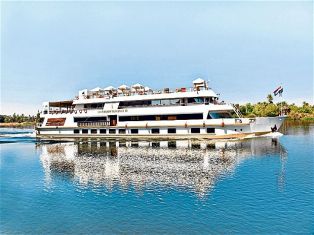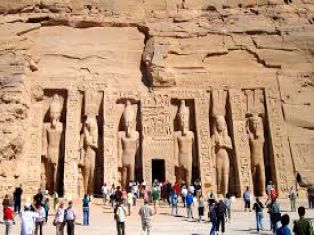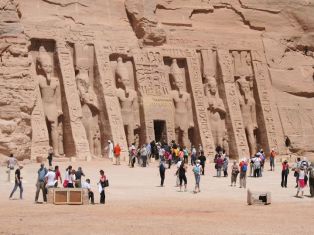Kom Ombo Temple
General Info:-
The city of Kom Ombo is located about 59 km south of Edfu was probably one of the most prosperous cities of Egypt during the Ptolemaic period because it was the place where the African elephants were trained for the Ptolemaic army , secondly it was the capital of a separate province and on the road for the gold mines of the eastern desert and the caravan track to Nubia , thirdly it was the home of two gods Horus the elder , and the crocodile deity Sobek, who together with their associated gods formed the two triads worshipped here in antiquity . The ancient site of the city of Nobet, later called by the Greeks Ombos, The temple of Kom Ombo is 3 km SW of the modern town, situated on the east bank of the river, its situation, one of the most magnificent throughout the nile valley, is due to the eastward shift of the river, the sand banks so closed must have been a favourite place for the crocodiles to sunbath, so it is not surprising that the site is associated with Sobek the crocodile god, however the temple is unusual in that it is dedicated to two gods Horus the elder and the crocodile Sobek . The district in which Ombos was situated was known as the great seat or the great throne, drived from the seat on which the goddess Tef-Nut sat when she visited the area , while Raa was upon his campaign, the site in myth was associated with Raa's fight for supremacy against Seth, in which struggle he was aided by Horus the elder, thus the two Horuses are amalgamated as the elder he helps his father Raa against Seth for the possession of Egypt, as the younger, he is Horus the avenger of his father, fighting the same enemy to avenge Osiris. The area of Kom Ombo is known to have settled from the prehistoric times and several early cemeteries have been found in the neighborhood, while the present Ptolemaic and roman temple built of sandstone from Gebel el-Silsla can only be the last of a long series of shrines on the same spot.
Description of the Temple:-
The temple is divided to two halves, the eastern half of the temple is dedicated to Sobek-Raa, his wife Hathor and his son Khonso–Hor, this part of the temple was called per-Sobek or the house of Sobek. The western half of the temple is dedicated to Horus the elder, his wife Hathor and his son the young Horus (pa neb tawy).
The Outer Gate:-
Modern stairs leading to the gate and the outer walls of the temple which was built during the reign of Ptolemy XII, but now completely destroyed and slipped into the nile.
The Open Court:-
Pass into the temple's forecourt, which is the first of the cult chambers to be shared between the two lords of Kom Ombo, Sobek's share is on the east side, while Horus owns the western half, otherwise the layout of the temple is very similar to Dandara or Edfu, the remnant of the columned portico around the forecourt (built by the romans) still retains much of its original paint. In the centre of the court is an altar base, with a small granite basin sunk into the pavement at either side, perhaps to catch the libations that flowed during ceremonies held during the great processional feasts each year. The reliefs in the open court shows the king Ptolemy XII purified by the two gods Horus and Thot before the god Sobek and another scene before the god Horus the elder.
The First Inner Hypostyle Hall:-
The hall has the finest examples of the late Ptolemaic work, the hall Supported by 15 columns in 3 rows, the columns capitals are of palm leaves, papyrus and composite designs. To the left of the entrance of the hall, the king Ptolemy XII can be seen during the coronation ceremonies wearing the crown before the god Horus the elder. The same scene carved on the other side of the hall shows the king Ptolemy XII wearing the crown before the god Sobek-Raa.
The Second Hypostyle Hall:-
A double door at the rare of the first hypostyle hall leading to the second hypostyle hall supported by 10 columns in 2 rows, the columns capitals are of papyrus & lotus flower designs. The reliefs in the second hypostyle hall , on the left of the entrance shows the Ptolemaic king leaving his palace and in front of him standing the priest, then the common scene of purification between Horus & Thot, then the coronation scene between the goddess Nekhbet of upper Egypt wearing the white crown and the goddess Wadjet of lower Egypt wearing the red crown and both of them crowning the king with the double crown, then comes the most important scene shows king Ptolemy VIII with queen Cleopatra II & Cleopatra III, receiving the sword form the god Horus. Two doors at the end of the hypostyle hall leading to 3 vestibules, the outer vestibules decorated as are the next two vestibules to the order of Ptolemy VI, shows scenes of the foundation of the temple, Sheshat the goddess of writing laying out the temple with a measuring cord, there is also a scene of the king purifying a model of the temple, the most important scene of this vestibule is the feasts list which is known as the Egyptian calendar that consists of 3 seasons (flood, growth and harvesting) . The middle vestibule served as a hall of offerings and only priests were allowed into this area, on the north wall of the third vestibule (the inner vestibule) two doors are the entries to the sanctuaries of Horus and Sobek.
The Dual Sanctuaries:-
The two sanctuaries were the work of Ptolemy XIII, they seem to have been much smaller than those at Dandara and Edfu, there was in each case a door in the rear wall, each sanctuary with a separate grey diorite altar, the walls of the two sanctuaries have been destroyed down to ground level, and Under the sanctuaries are triple undecorated crypts. At the end of the sanctuaries are a series of small unfinished chapels containing some interesting reliefs; behind the chapels is the most important scene of medical instruments dating to the 2 century AD, being presented to the god Imhotep god of medicine. Kom Ombo was one of those temples to which the pilgrims came to be healed, they fasted, spent the night in the temple precinct and were treated by the priests of Horus the good doctors, there is evidence of their presence in the many graffiti scribbled on the pavement of the outer corridor, they wrote their names in Greek, they draw their feet pointing towards the shrines, they played games with stones, and the boards on which they threw are carefully drawn out, they also draw ships, trees and other objects to while away the long hours of the night.
The Nilo Meter:-
Situated to the NW of the main temple is an hydraulic installation consisting of a large circular well with stairway and a rectangular basin, used to measure the level of the water of the nile river, especially during the season of the flooding of the nile .
recommended tours

Private Half - Day Tour: Philae Temple - Unfinished Obelisk & High Dam



